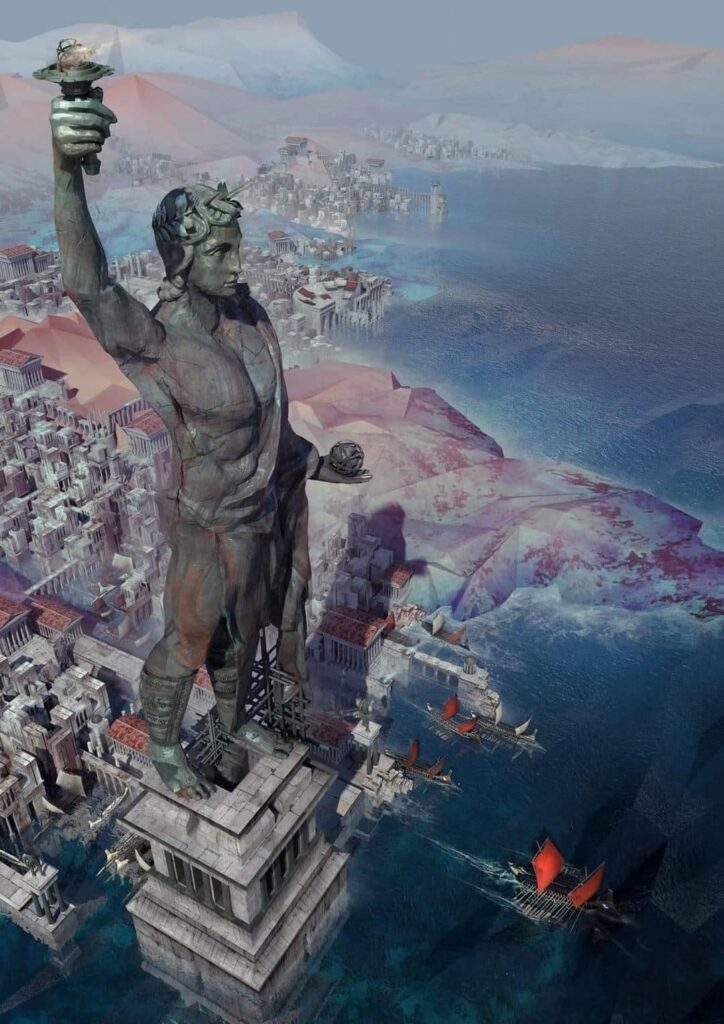Introduction: A Marvel of the Ancient World
The Colossus of Rhodes, one of the Seven Wonders of the Ancient World, stood as a symbol of human ingenuity and the resilience of the people of Rhodes. Towering at 157 feet (47 meters), this statue of the sun god Helios was not only a feat of engineering but also a testament to the cultural and political significance of the Greek world during the Hellenistic period. Although it only stood for 54 years before its collapse, its legacy continues to inspire curiosity and admiration.
Historical Context: Why Was the Colossus Built?
The Colossus was erected to celebrate Rhodes’ victory over the Cypriot army in 305 BCE, led by Demetrius I of Macedon. After a year-long siege, the people of Rhodes successfully defended their city-state, and to commemorate this triumph, they decided to honor their patron deity, Helios, the god of the sun.
The statue was funded in part by selling the abandoned siege equipment left by Demetrius’ forces, turning the remnants of war into a beacon of peace and unity. Its construction reflected the wealth and ambition of Rhodes, which was a major maritime and economic power at the time.
Construction: The Genius of Chares of Lindos
The Greek sculptor Chares of Lindos, a student of the famous sculptor Lysippos, was entrusted with the task of designing and building the Colossus. The project began in 292 BCE and took 12 years to complete. The statue was constructed using a combination of iron and brass, with its interior filled with stone blocks for added stability.
The innovative technique of earthen ramps allowed workers to assemble the towering figure piece by piece. As the statue grew, these ramps provided a way to transport materials to higher levels, showcasing the ingenuity of ancient engineering methods. The shining brass exterior not only symbolized Helios’ brilliance but also made the Colossus visible from great distances, serving as a welcoming landmark for ships approaching the harbor.

The Collapse: A Tragic End
In 226 BCE, just 54 years after its completion, the Colossus was brought down by a massive earthquake. The statue snapped at its knees and collapsed, leaving its fragments scattered across the harbor. Ancient records describe how even in its ruined state, the Colossus continued to awe visitors. According to the historian Pliny the Elder, few people could wrap their arms around the fallen thumb of the statue, a testament to its immense scale.
Despite offers to rebuild the statue, the Rhodians decided against it, fearing they had offended the gods. The remnants remained in place for over 800 years until they were reportedly sold to a traveling merchant after the Arab invasion of Rhodes in 653 CE.
Debates and Mysteries: Where Did It Stand?
One of the enduring mysteries surrounding the Colossus is its exact location and posture. Popular imagery often depicts it straddling the entrance to Mandraki Harbor with ships passing beneath its legs. However, this depiction is likely a myth, as the engineering challenges of such a pose would have been insurmountable with the technology of the time.
More plausible theories suggest that the Colossus stood on solid ground near the harbor or atop a pedestal on one side of Mandraki. While no physical traces of the statue remain, ongoing archaeological research and historical analysis aim to uncover more clues about its location.
The Legacy of the Colossus
The Colossus of Rhodes continues to captivate modern imaginations as a symbol of human ambition and creativity. Its construction showcased the advanced engineering and artistic capabilities of the ancient Greeks, while its fall serves as a reminder of the impermanence of even the greatest human achievements.
Today, the Colossus lives on not only in history books but also in cultural references, inspiring everything from literature to modern engineering projects. Proposals to rebuild a modern version of the Colossus have emerged in recent years, aiming to revive its spirit as a global symbol of unity and innovation.
Conclusion: A Monument Beyond Its Time
Although the Colossus of Rhodes stood for a brief moment in history, its impact has resonated through the ages. It represents a blend of artistic vision, technical prowess, and the enduring human desire to create something extraordinary. As we continue to explore its mysteries, the Colossus reminds us of the incredible achievements of the ancient world and the timeless allure of its wonders.
